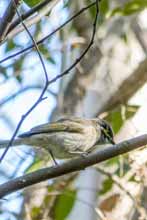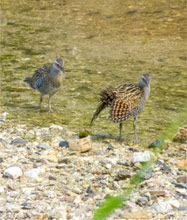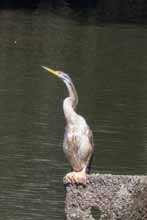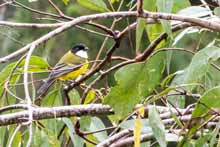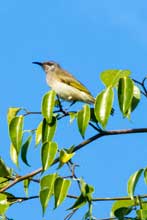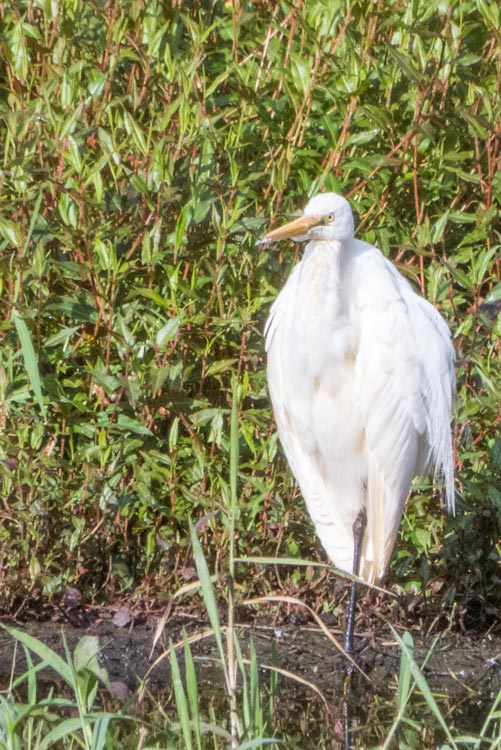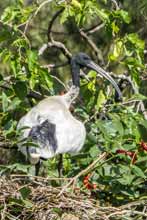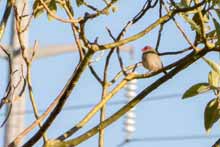Survey precautions
Links to Home and to other years
General details of 2015 observations
Detailed results for 2015
Summary of results of past walks
Additional walks
Contact
Background
This first page will be used to outline the general manner in which these bird walks are conducted, observations made and their recording. Since 2008, at least ten bird walks have been conducted each year in set locations selected as being representative of bird habitats along Kedron Brook.
For convenience, those records of observations during walks for the current year are being accumulated at first on this introductory page. At the end of each year, the results will be moved to a specific page for that year together with any tabular results and images. A link bar on each page allows an easy shift between the pages for each year and back to this introductory page that includes the results for the current year to date.
This project aims to accumulate data on bird life along the Brook, specifically those variations in birds species noted together with their distribution. A similar program has been set up each year but it is based upon a randomisation of the actual sequence of the locations to be visited over the year. This step is to minimise any seasonal effects on the number and type of birds species to be found at a particular location. The apparent absence of a particular species of bird at such a location for one or so years may possibly be explained by a migration influence.
Although we have a number of catchment members that are experienced birders, the leadership of Dawn Muir, supported by Esther Townsend (both experienced birders within Birds Queensland) has been vital. Their contributions to the success of this project have been most appreciated.
The program for 2016 is available now. Interested persons should also check the latest news in the home page project section to keep up to date on the next walk and possible changes due to poor weather or leadership availability.
General precautions to be used during these observations
These outings need to be carried out in small groups to reduce disturbance of, often, quiet elusive birds. It takes members of reasonable experience to be able to observe and identify birds correctly. However, there has been opportunity for new keen birders to join and learn the ropes on all of our outings.
Birders should bring their own personal food and water requirements and sun and skin protection (sunscreen and insect repellent). Although most outings are conducted along made paths, sometimes it is necessary to move carefully into bushland to more closely observe bird movements. Clothes and footwear should be chosen to suit these conditions, where possible. Travelling through natural flora and fauna habitats is usually of relatively low risk (compared with the risk of crossing busy roads) but skin irritations from harmful plants or tick bites can occasionally concern sensitive individuals.
Links to Home and to other years
General details of 2015 observations to date
Details of the locations and general arrangements for each walk are available in the yearly programs. Link to the program for 2015 here.
Bellbird Grove/Brisbane Forest Park - 1 February 2015, 7 am
Nine birders joined together in our first survey of 2015. The morning was fine and sunny - cool enough to be pleasant, but threatening to become a very warm day. Recent rains meant that good water was flowing in the creek which looked really lovely. Surprisingly, the only water birds seen were four Pacific Black Ducks on the dam.
At total of thirty-nine species were recorded: thirty-five sighted and four heard. Of special interest was the very exposed nest of the Variegated Fairy-wrens. Initially, we thought this was a nest under construction as the birds were observed carrying nesting material. But a check on the site later revealed the female bird was actually feeding a chick. It was also interesting to see one Red-browed Finch so high up in a tree - and on its own. Conversely, a Little Shrike-thrush posed for us allowing everyone a good view of its lovely colour and eyes.
We met two volunteer rangers who were very interested in our survey. Together, we then shared seeing a pair of Bush Stone-curlews nesting on the ground and pair of Tawny Frogmouths high above near the picnic shed.
Kalinga Park - Cressey St Wetlands-1 March 2015, 7 am
Seven observers met on Sunday 1st March to take part in the survey of Kalinga Park and Cressy St wetlands. There was clear evidence of the flooding which occurred over the weekend of 21/22 February following a rain depression and Cyclone Marcia. Also, there was more activity than normal in the area as in addition to usual park users, it was 'Clean up Australia Day and a private school was hosting a fun run along the pathways - with several hundred young participants.
A total of forty-four species were observed. A special mention must be made of the large number of Buff-banded Rail seen: some with chicks. The first rail was observed close to the walking path and it was so intent on finding food, it ignored the many passers by as well as the photographer intent on catching the 'best' shot. Later, a family of Rail was sighted running across the dual purpose bike/pedestrian path, and one cyclist was obliging enough to wait as a second adult with chicks also crossed the pathway.
Whilst Australian Brush-turkeys are fairly common in the area, it was interesting to see juveniles of varying ages scratching along the creek.
Albert Bishop Park-Kedron Brook Wetlands - 12 April 2015
Five observers met at the Nundah Cemetery on a fine clear morning with cool temperatures. A total of forty-nine species was observed, with good sightings of water birds and two raptors, a Brahminy Kite and Whistling Kite, at the wetlands lakes.
There was a lovely sighting of White-breasted Woodswallows all obligingly lined up on the football nets for a photo! A rollicking game was observed between three young male Australian Magpies testing out their strengths. Brown Honeyeaters and Striated Pardalotes were heard calling out in large numbers.
Nudgee Waterhole and Nudgee Beach - 3 May 2015
An enormous amount of rain fell over the Brisbane area on 1 May but there was no significant wind and no damage. At Nudgee, the waterhole was found to be full with water and covered across the circular path around the waterhole in places. Floodwater had been over the boardwalk but had drained away by Sunday. The usual stopover for bird observations was also made at the boat ramp area along the Kedron Brook Floodway and finally, at Nudgee Beach at the outlet of Kedron Brook into Moreton Bay. Contrary to past experience, no dogs were found in the protected area of beach at the Brook outlet!!
The highlight of the day was the two Darter nests found with two chicks in each. There were a couple of Little Pied Cormorant nests nearby but they were hard to see well enough for positive identification. In addition, a Gull-billed Tern, though known to be relatively common, was observed for the first time during these observations since 2008.
Cedar Creek - 14 June 2015
It was a bleak and overcast morning with plenty of rain. There was some difficulty manouvering umbrellas, binoculars and note books - but somehow the eight intrepid observers managed to score a total of forty-one species which included four unsighted but clearly identified by specific characteristic calls.
Not included in this number was the sighting of two female Fairy-wrens some distance off in the unhelpful drizzle at the time. A good score for such miserable weather conditions.There was about a dozen juvenile Australian Brush Turkeys sighted along the length of the creek covered. Many Blue-faced Honeyeaters were forraging for insects in the trees. Two female fairy wren's were sighted, but the weather conditions prevented any decision on what species they were. A very large flock of Topknot Pigeons flew overhead; an occurance often observed in this area. Rainbow Bee-eaters were heard but not seen until we headed back to the cars where quite a number were seen past the playground.
Grinstead Park and Sparkes Hill - 5 July 2015
Eleven enthusiasts met in the carpark at Grinstead Park on a fairly fresh, cool but sunny morning. A total of fifty species was observed (fifty-one if we include the pair of lovebirds on a blanket!). There was a great sighting of a pair of Pacific Baza flying overhead, so low that their markings were clearly visible by eye. They came back for an encore soon after; in case anyone missed them.
On the western side just near the Shand Road underpass, we saw all three species of Fairy-wren and a flock of Silvereyes; which was lovely. Near the top of Sparkes Hill, we sighted Rainbow Bee-eaters, several Scarlet and Brown Honeyeaters, and another frisky flock of Silvereyes.
Grange Forest Park - 2 August 2015
Thirteen enthusiasts braved the chilly morning air to assist with this days survey but it did turn into a lovely morning with lots of interest. At the beginning, there was even some mystery: a 'Bird of Prey' causing immense avian agitation all around but the villian was never actually sighted or heard. However, the warming sunshine soon helped us the enjoy the birding and we observed a final total of fifty-four species; of which two were identified only by their characteristic calls.
Scaley-breasted Lorikeets were plentiful. It was pleasant to see a small flock take off in orderly fashion from a large flowering Eucalypt. On the other hand, many of us found it difficult to pick out a small flock of Double-barred Finches that were feeding within an almost camouflaged area of small scraggly scrub in the warming sunshine. Of special interest during this birding walk, was the close observation possible of two pairs of Black-fronted Dotterels - one pair each was sighted at either end of the survey area.
Thomsett, Bob Cassimaty and Arbor Parks, Ferny Grove - 6 September 2015
Eleven enthusiasts gathered for this Father's Day survey on a fine, cool morning. A total of thirty species were sighted; nine less than found in the last survey in July 2014. We were pleased to see that a pair of Masked Lapwings had successfully raised a pair of almost fully fledged chicks. Little Corellas were observed trying to enlarge a nesting hole in a tall Eucalypt when a Pied Currawong swooped down and disturbed their activity for a while. Buff-banded Rails were busy feeding in two separate locations close to the Brook within our survey area.
Interestingly, on this occasion, we saw no Bush Stone-curlews and no Australian Brush-turkeys; both of which are normally common to this area. Also missing were the common species of Honeyeaters seen there over past years. However, it was great to see that Striated Pardalotes were still found to be nesting happily in the concrete drain holes of the Samford road bridge.
Wahminda Grove- Maureen Lawrence Park - 11 October 2015
Eight observers gathered at Wahminda Park in fine sunny conditions on a pleasantly cool morning. It was exciting to see three species of Lorikeets together near the parking area, namely Rainbow Lorikeets, Scaly-breasted Lorikeets and Little Lorikeets; all feeding in the blossom of a tall gum. A Superb Fairy-wren was sighted going up another very tall gum with his mate following behind. It's not common to see them quite so high in the canopy. It was also interesting to be able to observe several Eastern Whipbirds at play in the sparsely-leafed Lantana. These birds are usually difficult to see but there were really good sightings by all of the members of our group.
We disturbed some Pale-headed Rosellas in Maureen Lawrence Park. It was interesting to find them feeding on weed seeds close to the ground. Soon after, we had a very good sighting of an Olive-backed Oriel that we had heard singing all along the creek. Thirty-seven species were recorded over the two adjacent areas in just under three hours.
A pair of our observers stayed over to enjoy morning tea at Wahminda Park. They noticed the birds (particularly Magpies and Pied Butcherbirds) were quite noisy and sounded different. Our pair looked up and there was a large Carpet Snake (approx. 2 m long) gliding by. It looked very well fed. Magpies, Butcherbirds, Noisy Miners & Sulphur-crested Cockatoos pursued the snake and were very noisy. Birding can be quite exciting!
Pony Club Bend and Teralba Park - 1 November 2015
Eight enthusiasts gathered on a fine cool, though somewhat overcast, morning on Sunday, 1 November.
We were pleased to see several little groups of Red-backed Wrens, and some White-browed Scrubwrens. A pair of Pacific Black Ducks took great care of the two chicks remaining in their care upstream of the Pony Club Bike bridge. Although we looked and looked for a Buff-banded Rail (often seen in this area) it wasn't until we were on our way back that one was finally sighted. A large bird of prey was spotted being attacked by numerous other birds and it turned out to be a Pacific Bazza.
Detailed results for 2015
Results of birds observed on each walk may be linked from this table as the outcomes of any completed studies for this year become available.
| Date | Link to | Description |
|---|---|---|
| 01/02/2015 | 24KB pdf file | Bellbird Grove, Brisbane Forest Park |
| 01/03/2015 | 24KB pdf file | Kalinga Park - Cressey St. Wetlands |
| 12/04/2015 | 24KB pdf file | Zion Hill, Nundah, and Kedron Brook Wetlands |
| 03/05/2015 | 24KB pdf file | Nudgee Waterhole Reserve through to Nudgee Beach |
| 14/06/2015 | 24KB pdf file | Cedar Creek, Upper Kedron |
| 05/07/2015 | 24KB pdf file | Grinstead Park and Sparkes Hill Reserve |
| 02/08/2015 | 34KB pdf file | Grange Forest Park |
| 06/09/2015 | 22KB pdf file | Bob Cassimaty, Thomsett and Arbor Parks, Ferny Grove |
| 22/09/2015 | 19KB pdf file | Upper Kedron (Not to be included in regular yearly records) |
| 11/10/2015 | 23KB pdf file | Wahminda Grove - Maureen Lawrence Park |
| 01/11/2015 | 23KB pdf file | Pony Club Bend, Mitchelton, and Teralba Park |
Summary of results of past walks
Details of all the studies for 2008 through to 2014 are given in the table, 'Table 1 KBCB_WPSQ Results of Bird Studies 2008 - 2014, Summary of study dates, location codes, actual locations and conditions'. This is a small pdf file. Each study location code consists of an acronym of the location name together with a four numeral bit that represents the month and year. Thus, the code, 'FG-AP-BCP-0714, represents Ferny Grove, Arbor and Bob Cassimaty Parks, specifically as conducted in July 2014.
A set procedure of statistical analysis of all of the completed bird observations for past years was carried out using Microsoft Excel worksheets and suitable pivot table analysis to obtain summary information about the surveys. This will become clearer by a viewing of the resultant tables, especially for year 2014 by way of example.
The bottom section of Table 1 (see first paragraph above) contains the 2014 location codes with details of their location, the date of survey, conditions and leader. The location code is needed to assist the interpretation of the next table entitled, 'TABLE 2A - KBCB-WPSQ - Common name of bird species found at given coded location for bird observations at the eleven walks conducted for 2014 (Alphabetic order)'. In column one, the common name of the specified bird as specified by Christidis & Boyles (C&B) is given in alphabetic order down the table. A numeral '1' in the column below any given location code indicates that at least one bird of the species named for that row was observed (or heard with the specific characteristic call) for that location.
As an example of the use of this 'Table 2A', the fourth column with the 'FG-AP-BCP-0714' location code represents the survey conducted at Ferny Grove, Arbor Park, and Bob Cassimarty Park in July 2014. The top row for that particular column indicates that there wasn't any Australasian Grebe observed but the next row down indicates that the Australian Brush-turkey was observed for that survey; and so on.
The companion table, 'Table 2C - KBCB-WPSQ -Common name of bird species found at given coded locations for bird observations at the eleven walks conducted in 2014 (Christidis & Boyles)' gives virtually the same information. However, the rows are sorted in a different sequence based mainly upon that given down the 'Qld' column of the 'Australian bird list by state' spreadsheet, as obtained from the Birds Queensland web site about 2008. Serious birders generally use some ordering method based upon a scientifically accepted sequence of names of genus and species for birds. The latter information in turn was influenced by the original authorative reference by Christidis & Boyles (C&B).
However... note that the 'Seq' number used for these KBCB bird listings is no longer used by Australian Birding organisations. In 2014, Birdlife Australia set out their updated 'Birdlife Australia Working list of Australian Birds'. Link to their relevant website page that explains some of the problems with species classifications and the need to have some uniform approach to these bird lists within Australia. In fact, over recent years, changes were still being made with the names of some bird species and thus the once-favoured C&B listing sequence is no longer specifically followed by most birding organisations..
Birds Queensland has incorporated these recent official changes and uses the latest listing by the International Ornithological Congress (IOC). A table, entitled 'New Order - IOC' indicates those changes in name of twelve bird species in Queensland of which only four or so are mentioned within these KBCN bird observation records. For the benefit of consistency within these existing KBCB observation results, the original C&B system will continue to be used in these listings for at least until end of this 2015 year. Eventually, it may be possible to arrange all of the yearly results covered within one large table using the IOC system for continuity.
Additional walks
Occasionally, we go birding outside our normal set areas along the Kedron Brook Catchment. One of the Brook's major tributaries, Cedar Creek, rises from near Camp Mountain and runs through Upper Kedron (UBD Map 137 Ref A10) across Ross Road. This is an area threatened by adjacent new housing developments but, to date, still has forested areas, especially along the creeks. On 28 August 2015 a pair of birders took a look to evaluate the general effect of the developments upon the bird population (UBD Map 137 ref B9 to C9). On 22 September 2015, the pair were strengthened by the support of Dawn Muir (Birds Queensland) and repeated the survey.
The results of the observations made are available in the table above. Thirty species were recorded on the August walk and thirty-three species on the September walk. Due to the different types of birds seen on each survey, there was a total of forty-three bird species recorded over the two walks; mainly alongside the creek. At least one species of quail was also noted on the September walk. Given the present conflict between local government, housing developers and environmentalists, it is uncertain that the integrity of habitat of this part of the catchment will be maintained by council.
Contact
Bird lovers are always welcome on our walks but note the special precautions above to ensure happy birding. Factors such as weather and availability of leadership mean that some outings may need to be changed at relatively short notice. Please contact Outing Coordinator, Jenny Ivin, on phone 3851 0160 or for further information.
CI 3/11/2015



